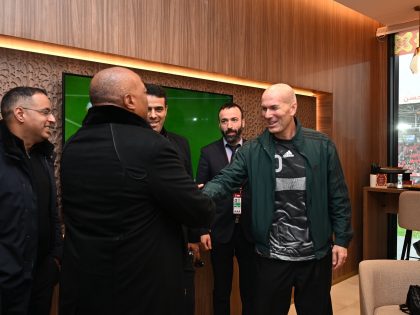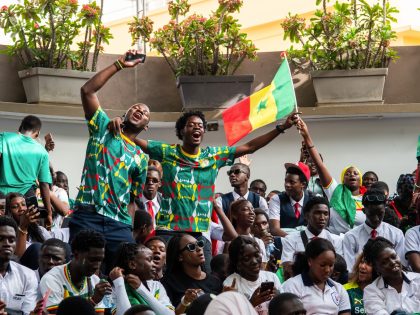Tuareg Rock
The unexpected popularity of British rock band, Dire Straits, among North Africa's Tuareg communities.

Dire Straits in Hamburg in 1978. (Wiki Commons).
When Tinariwen released the critically acclaimed album Amassakoul in 2003, they gave the wider world its first taste of Tuareg popular music. Dominated by electric guitars and driven by a hypnotically repetitive groove, the group held an obvious appeal to audiences raised on rock. The album’s filigreed, interlocking riffs and hoarsely passionate vocals — not to mention the boogie-like rumble the band attained at its most feverish moments — were seemingly cousins to the American musical tradition; close enough to feel familiar but different enough to excite.
For a band from the isolated desert regions of the Sahel to attain this kind of success, it’s vital to have a powerful narrative for the press. And to Tinariwen’s credit, they’ve managed this aspect of their career brilliantly, leaving a trail of articles about the “raw roots of rock” and “desert freedom fighters” in their wake. None of this is wrong per se, but if you read it enough times, it can become difficult to separate the hype from what is inevitably a more complex reality. And that’s why the Dire Straits name checking was such a remarkable detail.
Pretty much any time a journalist asked either a member Tinariwen or one of the many other Tuareg groups that followed in its wake about their influences, they would mention the obvious legends (usually Jimi Hendrix and Bob Marley) and then Dire Straits. Like “Sultans of Swing,” “I-Want-My-MTV” Dire Straits. Which didn’t seem to make any sense. Roughly 100 percent of the people who have ever picked up a guitar claim to be influenced by Jimi Hendrix, and basically everyone born after 1970 loves Bob Marley. But these Tuareg groups are the only African musicians I’d ever heard even mention Dire Straits, let alone describe them as a primary influence. And yet there it was, in interview after interview. What was going on? To understand, it’s necessary to go back to the beginnings of Tuareg popular music.
Tinariwen, Tamikrest, Toumast, Terakaft, Bombino, Tartit, Amanar, Mdou Moctar… Given the number of Tuareg groups currently performing on stages around the world, you’d be forgiven for thinking that the nomads who live in the vast northern regions of Mali, Niger and Burkina Faso have long had a tradition of guitar-based music. Surprisingly, nothing could be further from the truth. In fact, go back to the early 1990s, and you’d be hard pressed to find more than a handful of Tuareg guitarists, let alone a thriving scene of bands.
Traditionally, Tuareg culture is a matrilineal (a holdover from pre-Islamic times), and their music is no exception. While the men would sometimes sing hunting or herding songs, for the most part, music-making was a female responsibility. This began to change as events in surrounding areas began to transform the Tuareg way of life.
When the nations of West Africa gained independence in the 1960s, the traditional homeland of the Tuaregs was split among the new countries. The nomads were now citizens, subject to laws passed in far-off capitals, and their migrations were border-crossings, many of them illegal. Dissatisfied, and hoping to win a nation of their own, the Tuaregs living in Mali revolted against the new government in 1962. The attempted revolution put down harshly, and the Malian military was often brutal, killing livestock and displacing families. As a result, thousands of Tuaregs fled north across the desert to Libya and Algeria. This movement was accelerated by the droughts that began to ravage the Sahel in the ‘70s and ‘80s.
The combination of politics and climate forced a generation of Tuareg men north and west in a desperate search for employment and safety. While the Tuareg had always been nomads, this movement was new. Breaking and blending the lines of tribal affiliation, the harsh border crossing (many would walk across hundreds of kilometers of desert with only a five-liter can of water for sustenance) brought the Tuaregs forcefully into a new world, one in which they had become a politically marginalized minority on the outskirts of settled society.
Paradoxically, it was this brutal period of diaspora that allowed for the creation of Tuareg popular music. Living in shantytowns or ghettos on the outskirts of cities, sometimes without any women around, Tuareg men began to actively perform music. At the same time, the experience of violent dislocation began to create a new form of Tuareg nationalism, as a revolutionary movement began to bubble through the camps.
The earliest incarnation of Tinariwen was directly tied to this new political consciousness. Using music to spread revolutionary propaganda (in the form of poetry), the group’s earliest cassettes would sometimes start with a member reciting the text without accompaniment, just so listeners couldn’t possibly miss the point. When fighting broke out again in the 1990s, the music of Tinariwen, copied from tape to tape, was its inescapable soundtrack
Then, almost by accident, politics created the space for pop. Where there had previously been only traditional music, there was now an entire genre connected to youth culture. When a fitful peace was reached in the mid-’90s, a new generation of musicians sprang up to follow the example of Tinariwen.
And this seems to be the crucial moment when Dire Straits became the touchstone for a rapidly developing music. As a result of increased movement during the ‘80s and ‘90s, a steady stream of guitars and tapes had begun to flow into the desert. And while the young Tuareg may have wanted to listen to their own music, Tinariwen was really the only band to have any recorded material. So, musicians and fans had to look beyond their borders for sounds. And what they found were the superstars, the bands so popular that their tapes had made it to the Sahara. That’s Marley, Hendrix, and… Dire Straits, who had absolutely dominated the European rock market in the 1980s. Five years in either direction, and their music wouldn’t have mattered. But as it was, it became essential.
With a style simpler and less-distorted than Hendrix’s, Mark Knopfler, the lead guitarist for the band, became the single biggest foreign influence on the development of Tuareg ishumar (or “desert blues”) music. His lightning-fast licks and precise, biting articulation linked perfectly with the swirling modal playing that defined the lute styles that the new bands had already begun to adapt for electric guitar. While it’s hard to prove definitively, it seems as if the popularity of groups like Dire Straits did a great deal to move Tuareg music away from genres like rai and towards a harder, more rock-influenced sound. The sound of Tuareg music was a choice, the creation of composers deliberately picking between competing influences in an effort to reshape their traditions to meet their current needs. While it may be heartfelt, there is nothing “primal” about it. Time-wise? It’s been around about a decade less than hip-hop.
These days, younger Tuareg musicians don’t listen to much Dire Straits anymore — they don’t need to. At this point, there are more than enough Tuareg groups to keep them satisfied. But that older generation still bears unmistakable DNA from the sultans of swing. And maybe that’s another reason why Tuareg groups like Tinariwen are so popular in the West. In their guitar playing, we hear rock music adapted, transformed, and then transmitted back to us. But the critics have it wrong — we aren’t hearing ancient echoes, but rather a distinctly modern interpretation.



















